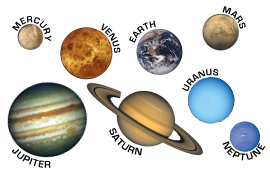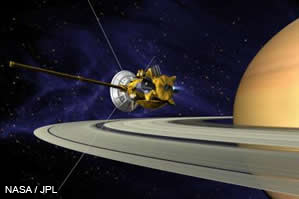
 We can see up to five planets in the sky with our naked eyes. However, at any time, some of them might be too close to the Sun for observation or they may be beneath the horizon. The word planet originally meant "wanderer" because ancient astronomers noticed that they moved compared to the pattern of stars. The cover photo of the Star Finder shows that movement. Venus is just above the right horizon; Jupiter is 45° away beside "Eastern Horizon." Six weeks later, they passed each other.
We can see up to five planets in the sky with our naked eyes. However, at any time, some of them might be too close to the Sun for observation or they may be beneath the horizon. The word planet originally meant "wanderer" because ancient astronomers noticed that they moved compared to the pattern of stars. The cover photo of the Star Finder shows that movement. Venus is just above the right horizon; Jupiter is 45° away beside "Eastern Horizon." Six weeks later, they passed each other.
Planets don't twinkle as much as stars because they are discs rather than tiny points of light. Through telescopes and good binoculars, you can see the disc of many planets and the wonderful rings of Saturn. In some years, the rings are tilted to us and easy to see, at other times such as 2009, (and 1612 after Galileo reported them) the rings are almost edge on and hard to see. Mars is a tiny disc when it is on the other side of the Solar System, but it appears quite large when it is closest to the Earth at opposition, such as in January 2010.
 Spacecraft have flown by every planet and have landed on Venus and Mars. Different missions will fly by dwarf planet Pluto and orbit dwarf planet Ceres, both in 2015. Pluto was demoted by the International Astronomy Union in 2006 because it's much smaller than every other planet, and there are probably several other objects bigger than Pluto in the outer reaches of the Solar System.
Spacecraft have flown by every planet and have landed on Venus and Mars. Different missions will fly by dwarf planet Pluto and orbit dwarf planet Ceres, both in 2015. Pluto was demoted by the International Astronomy Union in 2006 because it's much smaller than every other planet, and there are probably several other objects bigger than Pluto in the outer reaches of the Solar System.
The Solar System is mostly, but not exactly flat. Because of that, the Sun, Moon, and planets all move through the same region of sky. This is shown by the yellow band on the Star Finder. It's labelled "Path of Planets," but astronomers call it the "ecliptic" because all eclipses occur there.
The constellations on the Path of Planets are the signs of the zodiac. Many of the ancient sky watchers were really astrologers looking for relationships between earthly and celestial events. Modern astronomers have found no connection between our day to day lives and the positions of solar system objects - unless an object is found which might hit our planet. Astronomy is science while astrology is a belief system.
Astronomers have found many planets around other stars. Most so-called exoplanets have been found by measuring how stars move back and forth as the unseen planets orbit their parent star. The most massive planets are easiest to find by this technique, but smaller and smaller exoplanets are being found. New space missions will be sensitive to planets as small as the Earth.
The properties of the atmosphere of some Jupiter-sized exoplanets have been determined from the way they reflect light from their parent stars and how they interfere with that starlight when they pass in front of the star. Very large telescopes and new instruments currently planned may be capable of obtaining infrared spectra of an Earth-like planet. These spectra could be sensitive to the presence of life on that planet. The first proof of life that sprung up elsewhere in the Universe would be a momentous discovery.

The following chart from "The Sidewalk Astronomer" shows where to find each planet for each month. If no constellation is given, the planet is close to the Sun. Venus and Mercury move very quickly and can be in several constellations in a month. They are just listed as "evening" or "morning." Venus is usually brighter than any other star. For fast-moving Mercury, the date it is most visible is given. Because Mercury is so close to the Sun, it is seldom against a completely black sky.
NASA provides lots of amazing photos of the planets. Have a look on this great site:
| Attachment | Size |
|---|---|
| 215.45 KB |
